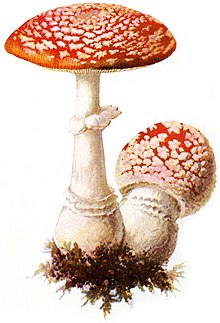
Back أمانيت Arabic امانيت ARZ Amanita AST Amanita Azerbaijani Тырҡыш Bashkir Мухамор Byelorussian Мухоморки Bulgarian Amanita Catalan Amanita CEB Muchomůrka Czech
| Amanita | |
|---|---|

| |
| Amanita muscaria Albin Schmalfuß, 1869 | |
| Scientific classification | |
| Domain: | Eukaryota |
| Kingdom: | Fungi |
| Division: | Basidiomycota |
| Class: | Agaricomycetes |
| Order: | Agaricales |
| Family: | Amanitaceae |
| Genus: | Amanita Pers. (1794) |
| Type species | |
| Amanita muscaria | |
| Diversity | |
| c. 600 species | |
| Synonyms | |
|
Amanitopsis Roze | |
The genus Amanita contains about 600 species of agarics, including some of the most toxic known mushrooms found worldwide, as well as some well-regarded edible species (and many species of unknown edibility). The genus is responsible for approximately 95% of fatalities resulting from mushroom poisoning, with the death cap accounting for about 50% on its own. The most potent toxin present in these mushrooms is α-Amanitin.
The genus also contains many edible mushrooms, but mycologists discourage mushroom hunters, other than experts, from selecting any of these for human consumption. Nonetheless, in some cultures, the larger local edible species of Amanita are mainstays of the markets in the local growing season. Samples of this are Amanita zambiana and other fleshy species in central Africa, A. basii and similar species in Mexico, A. caesarea and the "Blusher" A. rubescens in Europe, and A. chepangiana in Southeast Asia. Other species are used for colouring sauces, such as the red A. jacksonii, with a range from eastern Canada to eastern Mexico.